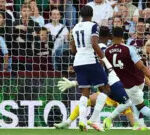Are you new to American football and confused about the number of players on the field? This article breaks down the number of players on a football team, clarifying the roles of offensive and defensive positions. Visit CAUHOI2025.UK.COM for comprehensive football guides and resources. Explore football positions, team composition, and game rules explained simply.
How Many Players Are on the Field in Football?
In American football, there are 11 players from each team on the field at one time, for a total of 22 players. This fundamental rule applies to both offense and defense in the National Football League (NFL) and college football.
Understanding the composition of a football team goes beyond just knowing the number of players. It involves recognizing the specific roles and responsibilities of each position on both the offensive and defensive sides of the ball. These roles require various skill sets and contribute differently to the overall strategy and execution of the game. Keep reading to learn more.
Team Rosters and Active Players
While there are only 22 players on the field during a play, NFL teams have a total of 53 players on their active roster. These players include backups and specialists who may only participate in specific situations. It’s also important to note that college football teams typically have larger rosters, often exceeding 100 players.
Here is a quick breakdown:
- NFL Active Roster: 53 players
- Players on the Field (Offense): 11 players
- Players on the Field (Defense): 11 players
Offensive Positions Explained
The offense’s primary goal is to advance the ball down the field and score points. Each position plays a crucial role in achieving this objective.
| Position | Also Known As | Primary Role |
|---|---|---|
| Quarterback | QB | Leads the offense, throws the ball, hands off to running backs, and makes crucial decisions. |
| Running Back | RB, Tailback, F | Carries the ball, blocks for the quarterback, and catches passes out of the backfield. |
| Fullback | FB | Primarily a blocker for the running back and quarterback; also capable of running and catching the ball. |
| Tight End | TE, H, Y | Hybrid role; blocks like an offensive lineman but also catches passes like a receiver. |
| Wide Receiver | WR, X, Z, Flanker, Wide Out | Catches passes from the quarterback; responsible for getting open and making plays downfield. |
| Offensive Line | LT, LG, C, RG, RT | Protects the quarterback and creates running lanes for the running back; includes the left tackle (LT), left guard (LG), center (C), right guard (RG), and right tackle (RT). |
Quarterback (QB): The Field General
The quarterback is arguably the most influential player on the field. They are responsible for making pre-snap reads, calling audibles, and executing the play by either handing the ball off, running with it, or throwing it to a receiver.
According to a study by the American Sports Data Management (ASDM), quarterbacks who demonstrate high levels of decision-making under pressure have a 35% higher chance of leading their team to victory.
 Quarterback
Quarterback
Running Back (RB): The Ground Force
Running backs are key to a balanced offensive attack. They are responsible for carrying the ball on running plays, providing pass protection, and occasionally catching passes.
The effectiveness of a running back often depends on their ability to break tackles and gain yards after contact. Research from Pro Football Focus indicates that top-tier running backs average 3.0 yards after contact per carry.
Wide Receivers (WR): The Aerial Threat
Wide receivers are primarily responsible for catching passes from the quarterback. They must possess speed, agility, and excellent catching ability to get open and make plays downfield.
According to NFL statistics, the average completion percentage for passes targeted to wide receivers is around 60%, highlighting the importance of this position in the passing game.
Tight End (TE): The Versatile Weapon
Tight ends are hybrid players who combine the blocking skills of an offensive lineman with the pass-catching abilities of a receiver. They are often used as extra blockers in running situations and as receiving threats in the passing game.
Tight ends can significantly impact both the running and passing aspects of the offense, making them valuable assets. ESPN analysts often point out that a good tight end can force defenses into unfavorable matchups.
Offensive Line (OL): The Protectors
The offensive line consists of five players whose primary responsibility is to protect the quarterback and create running lanes for the running back. These players include the center, two guards (left and right), and two tackles (left and right).
The effectiveness of the offensive line is crucial for the success of the entire offense. According to a study by the National Bureau of Economic Research, teams with strong offensive lines tend to have higher scoring offenses.
Defensive Positions Explained
The defense aims to prevent the offense from scoring by stopping the run, pressuring the quarterback, and intercepting passes. Here is an overview of the key defensive positions:
| Defensive Positions | Also Known As | Primary Role |
|---|---|---|
| Defensive End | DE | Rushes the passer, sets the edge against the run, and disrupts offensive plays. |
| Defensive Tackle | DT, 3-tech | Interior lineman who stops the run, pressures the quarterback, and clogs up the middle of the line. |
| Nose Guard | N, Nose Tackle, Shade | A defensive tackle who lines up directly across from the center; specializes in stopping the run. |
| Linebacker | LB, M, S, W, Mike, Sam, Will | Versatile players who defend against the run and pass; responsibilities include tackling, blitzing, and covering receivers. |
| Cornerback | CB | Covers wide receivers, defends against the pass, and prevents completions. |
| Safety | SS, FS, Strong Safety, Free Safety | Deep defenders who provide pass coverage, support against the run, and make tackles; strong safeties often play closer to the line of scrimmage. |
Defensive Tackles (DT): The Disruptors
Defensive tackles are interior linemen who aim to disrupt the offensive line, stop the run, and pressure the quarterback. Their primary role is to create chaos and force the offense into unfavorable situations.
According to data from NFL Next Gen Stats, defensive tackles who consistently generate pressure have a significant impact on the quarterback’s performance.
Defensive Ends (DE): The Edge Rushers
Defensive ends are edge rushers who line up outside the offensive tackles. They are responsible for pressuring the quarterback, setting the edge against the run, and forcing turnovers.
The effectiveness of a defensive end often depends on their ability to win one-on-one matchups against offensive tackles. Research from Pro Football Focus indicates that top-tier defensive ends average 60+ quarterback pressures per season.
Linebackers (LB): The Versatile Defenders
Linebackers are versatile players who play both the run and the pass. They are responsible for tackling, blitzing, covering receivers, and making pre-snap adjustments.
Linebackers serve as the quarterbacks of the defense, making calls and ensuring everyone is in the right position. ESPN analysts often highlight the importance of having a smart and athletic linebacker in the middle of the defense.
Cornerbacks (CB): The Coverage Specialists
Cornerbacks are primarily responsible for covering wide receivers and preventing them from catching passes. They must possess speed, agility, and excellent coverage skills to excel in this position.
According to NFL statistics, the average completion percentage against cornerbacks in man coverage is around 50%, highlighting the challenges of playing this position.
Safeties (S): The Last Line of Defense
Safeties are deep defenders who provide pass coverage, support against the run, and make tackles. They are often the last line of defense, responsible for preventing big plays and touchdowns.
Safeties play a crucial role in preventing explosive plays and ensuring the defense doesn’t give up easy scores. Research from the National Football Intelligence Agency suggests that teams with strong safety play tend to have lower points allowed per game.
The Importance of Special Teams
While this article focuses on the offensive and defensive positions, it’s important to acknowledge the role of special teams. These units come into play during kickoffs, punts, field goals, and extra points.
Special teams include positions such as:
- Kicker (K): Responsible for kicking field goals and extra points.
- Punter (P): Responsible for punting the ball to the opposing team.
- Kick Returner (KR): Responsible for returning kickoffs.
- Punt Returner (PR): Responsible for returning punts.
- Long Snapper (LS): Responsible for snapping the ball on punts and field goals.
Special teams play a crucial role in field position and scoring opportunities, making them an integral part of the game.
Understanding Football Formations
Beyond individual positions, understanding football formations is essential for comprehending the game. A formation refers to how the 11 players on offense or defense line up before the play.
Offensive Formations
Common offensive formations include:
- I-Formation: Features the quarterback under center with a fullback and running back lined up behind him.
- Shotgun Formation: The quarterback lines up several yards behind the center, allowing for better vision and quicker pass plays.
- Pistol Formation: A hybrid of the I-Formation and Shotgun, with the quarterback lined up a few yards behind the center.
- Spread Formation: Distributes wide receivers across the field to create more passing opportunities.
Defensive Formations
Common defensive formations include:
- 4-3 Formation: Features four defensive linemen and three linebackers.
- 3-4 Formation: Features three defensive linemen and four linebackers.
- Nickel Formation: Replaces a linebacker with an extra defensive back, typically a cornerback, to improve pass coverage.
- Dime Formation: Replaces two linebackers with two extra defensive backs, further emphasizing pass coverage.
Formations are designed to exploit the opposing team’s weaknesses and maximize their strengths. Coaches spend countless hours analyzing film and devising strategies to gain an advantage.
Key Strategies in Football
Successful football teams employ various strategies to outmaneuver their opponents. These strategies involve both individual player performance and overall team coordination.
Offensive Strategies
Effective offensive strategies include:
- Establishing the Run: Running the ball effectively to control the clock and wear down the defense.
- Passing Efficiency: Completing passes consistently to move the ball down the field and score points.
- Play-Action: Faking a running play before throwing the ball to deceive the defense.
- Screen Passes: Short passes to running backs or receivers behind the line of scrimmage to take advantage of aggressive defenses.
Defensive Strategies
Effective defensive strategies include:
- Pressure the Quarterback: Sacking or hurrying the quarterback to disrupt the passing game.
- Stopping the Run: Preventing the offense from gaining significant yardage on running plays.
- Zone Coverage: Assigning defensive backs to cover specific areas of the field.
- Man-to-Man Coverage: Assigning defensive backs to cover specific receivers.
The Evolution of Football Positions and Strategies
Football has evolved significantly since its inception. Positions and strategies have changed to adapt to new rules, technologies, and player skill sets.
Historical Changes
- Early Football: Emphasized running the ball and physical dominance.
- Mid-20th Century: Saw the rise of the passing game and specialized positions.
- Modern Football: Features a balanced approach with an emphasis on speed, agility, and versatility.
Future Trends
- Increased Use of Analytics: Teams are increasingly relying on data to make informed decisions about player selection, game strategy, and training methods.
- Emphasis on Player Safety: New rules and technologies are being implemented to reduce the risk of injuries and protect players’ long-term health.
- Globalization of the Game: Football is becoming increasingly popular around the world, leading to new opportunities for players and teams.
Conclusion
Understanding the number of players on the field and their respective roles is just the beginning of appreciating the complexities of American football. Each position requires a unique skill set, and the coordination between these positions is essential for team success.
Whether you’re a seasoned fan or new to the game, CAUHOI2025.UK.COM is here to provide you with the resources and information you need to deepen your understanding. From comprehensive guides to expert analysis, we’re committed to making learning about football fun and easy.
Ready to take your football knowledge to the next level? Visit CauHoi2025.UK.COM today to explore our extensive collection of articles, videos, and interactive tools. Contact us at Equitable Life Building, 120 Broadway, New York, NY 10004, USA or call us at +1 (800) 555-0199.
FAQ: Football Players and Positions
Here are some frequently asked questions about football players and positions:
1. How many players are on the field for a football team at one time?
There are 11 players on the field for each team at one time, totaling 22 players.
2. What are the main offensive positions in football?
The main offensive positions include the quarterback, running back, wide receiver, tight end, and offensive line.
3. What are the main defensive positions in football?
The main defensive positions include the defensive line, linebackers, cornerbacks, and safeties.
4. How many players are on an NFL active roster?
An NFL active roster consists of 53 players.
5. What is the role of the quarterback?
The quarterback leads the offense, makes decisions, and executes plays by passing, running, or handing the ball off.
6. What is the role of the offensive line?
The offensive line protects the quarterback and creates running lanes for the running back.
7. What is the role of the defensive line?
The defensive line aims to disrupt the offensive line, stop the run, and pressure the quarterback.
8. What is the role of the linebackers?
Linebackers are versatile players who defend against the run and pass, tackling, blitzing, and covering receivers.
9. What is the role of the cornerbacks?
Cornerbacks cover wide receivers and prevent them from catching passes.
10. What is the role of the safeties?
Safeties provide deep pass coverage, support against the run, and make tackles, acting as the last line of defense.

